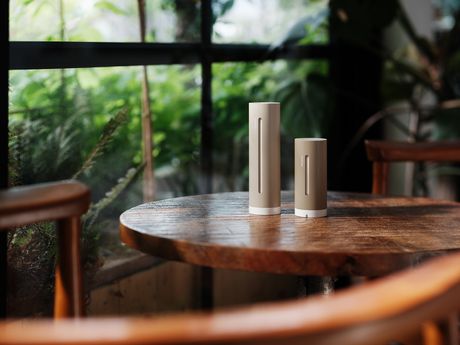
Netatmo präsentiert die Wetter Station ORIGINAL

Die wahrscheinlich bekannteste Eigenschaft der Infrarotkamera ist ihre Nachtsichtfunktion. Aber wie genau funktioniert eine solche Kamera?
Infrarotstrahlen sind Wärmestrahlen (oder thermische Strahlungen), welche von Lebewesen abgegeben werden. Die Infrarotkamera, welche manchmal je nach den gemessenen Wellenlängen auch Wärmekamera genannt wird, ist in der Lage, diese Wärmewellen zu erfassen und die genaue Kontur zu erkennen. Der integrierte Sensor in der Infrarotkamera ist also in der Lage, trotz Dunkelheit auch nachts zu sehen und Bilder aufzunehmen. Was Sie dann sehen, nennt sich Wärmebild. Dies ist der Thermografie zu verdanken, welche auch als Infrarot Wärmebildtechnik bekannt ist.
Ohne Blitzlicht zeigt das nächtliche Wärmebild auf der Infrarotkamera die Konturen des Körpers der Person in einer echten Farbe, welche sich vor der Tür oder dem Eingang befindet, wo die Infrarot Überwachungskamera platziert ist. Mit Blitzlicht haben die Wärmebilder eine höhere Auflösung und umfassen die gesamte Umgebung in Schwarz-weiß.
Wie sieht ein Infrarotbild eigentlich aus? Die Faktoren Auflösung, Pixel und Empfindlichkeit tragen alle zur Qualität des Infrarotwärmebildes einer Überwachungskamera bei. Unter normalen Umständen ist Infrarotlicht für das menschliche Auge nicht sichtbar, was die Infrarotkamera zu einem optimalen Sicherheitsprodukt für Ihr Zuhause macht. Sicher ist jedoch, dass eine hohe Auflösung zum optimalen Schutz des Hauses beiträgt. Informieren Sie sich daher vor der Anschaffung und dem Einbau genauestens bei dem Anbieter.
Der Hauptzweck einer Infrarot Kamera besteht darin, dank der Nachtsicht Ihr Zuhause auch in der Nacht zu überwachen.
Nachtsicht wird häufig zur Überwachung des Außenbereiches eines Hauses genutzt. Für viele ein sehr positiver Aspekt, welche zur Entscheidung einer Infrarotkamera zur Ergänzung Ihres Sicherheitssystems beitragen kann.
Und der Innenbereich? Auch hier erweist sich die Infrarotkamera als sehr nützlich, insbesondere wenn Sie bereits eine Alarmanlage und weiteres Zubehör zum Einbruchschutz in Ihrem Haus installiert haben. Hier ein Beispiel: Sie befinden sich im Urlaub und bekommen über Ihr Smartphone eine Benachrichtigung über einen Einbruchversuch bei Ihnen zu Hause. Dank der Infrarotkamera können Sie selbst nachts und aus dem Urlaub dank der Übertragung über WLAN die Bilder der Überwachungskamera ganz einfach auf der Netatmo Security App aufrufen und entsprechend handeln. Auch der Polizei helfen Bilder von den Einbrechern enorm bei den Ermittlungen, weswegen eine hohe optische Auflösung der Kamera eine entscheidende Rolle spielt. Wenn die Kamera lediglich die Umrisse des Gesichtes aufnimmt, kann die Polizei die Angaben nicht spezifizieren und die Suche somit nur schwer eingrenzen.
Eine Infrarotkamera ist also sehr nützlich für die Erkennung und Verfolgung von Einbrechern. Allerdings gibt es auch Zubehör, welches den Einbrecher bereits vor dem Durchbruch in die Wohnung oder das Haus abschreckt und diese Tat somit verhindert. Denn auch mit einer installierten Alarmanlage erzeugen Sie erst eine abschreckende Wirkung, sobald der Einbrecher bereits in das Haus eingedrungen ist. Als Vorsorge dienen beispielsweise Bewegungsmelder, welche mit der Infrarotkamera kompatibel sind und durch einen eingebauten Sensor die Bewegung von Personen oder erkennen können. Als Unterstützung zu den Bewegungsmelder gibt es auch Türalarme, welche Sie bei der erkannten Vibration der Tür informiert. Über die Überwachungskamera können Sie dann die Bilder einsehen.
Um den Innenbereich Ihres Hauses außerdem zu schützen, kann die intelligente Innenkamera von Netatmo für den Innenbereich in Kombination mit der intelligenten Alarmsirene Gesichter erkennen und Alltagsgeräusche abspielen und somit Einbrechern vortäuschen, dass sich jemand zu Hause befindet. Der größte Bonus: Sie müssen die Alarmanlage nicht manuell ein- und ausschalten, da die Anlage eine selbstständige Funktion für dieses Problem besitzt. Falls ein Einbrecher trotz einer vernünftigen Sicherheitsausstattung doch in Ihr Haus eindringen sollte, ertönt die laute Alarmsirene und erweckt somit automatisch auch die Aufmerksamkeit aller Nachbarn und der Einbrecher ergreift die Flucht.
Unsere Smarte Innenkamera, unsere Smarte Außenkamera und unsere Smarte Videotürklingel verfügen über Infrarot Nachtsicht. Eine Kombination dieser Produkte bietet ein Maximum an Sicherheit gegen Einbrecher.
Natürlich wirkt die Infrarotnachtsicht Funktion der Infrarotkamera allein auf Einbrecher nicht abschreckend. Die Infrarotkamera muss daher mit Bewegungsmeldern und/oder automatischer Beleuchtung wie beispielsweise einem Blitz kombiniert werden, um potenzielle Einbrecher abzuschrecken.
Das Beste an diesem Sicherheitssystem ist, dass Sie durch die eigenständige Steuerung und Echtzeitbenachrichtigungen über Ihr Smartphone selbst entscheiden können, wann der Alarm aktiviert werden soll und ihn mit nur einem Klick auf der App wieder deaktivieren können. Durch diese Technologie können Fehlalarme verhindert werden und Sie fühlen sich rundum sicherer.
Wenn Sie eine Infrarotkamera im Außenbereich Ihres Hauses einbauen möchten, sollten Sie gewisse Regeln und Tipps beachten. Es ist wichtig, dass die Kamera in einer gewissen Höhe hängt, sodass sie beim Entdecken seitens der Einbrecher nicht ohne Weiteres demoliert werden kann. Außerdem müssen Sie darauf achten, dass das Sichtfeld der Kamera lediglich Ihr Grundstück und nicht das der Nachbarn oder einen öffentlichen Bereich wie die Straße vor Ihrem Haus aufnimmt. Diese Bereiche gehören zum öffentlichen Raum und dürfen unter keinen Umständen von Privatpersonen überwacht werden, da es sich sonst um einen Verstoß gegen das Datenschutzgesetz handelt. Informieren Sie außerdem alle Bewohner vor Einbau bereits über das Vorhaben und im Idealfall auch alle Besucher, die in das Sichtfeld der Infrarot Kamera geraten.
Im Innenbereich sollte die Kamera ebenfalls strategisch platziert sein. Denken Sie darüber nach, in welchen Bereich Einbrecher zuerst vordringen würden und in welchen Räumen Sie am meisten Wertsachen lagern oder verstecken.
Nicht umsonst verfügt die Smarte Außenkamera von Netatmo zusätzlich zur Infrarotnachtsicht und Bewegungserkennung über eine automatische Beleuchtungsfunktion. Wenn die Infrarotkamera mitten in der Nacht durch den Sensor einen Einbrecher erkennt, schaltet sich die Beleuchtung der Kamera automatisch ein! Eine Kombination der intelligenten Netatmo Produkte sorgt für ein höheres Maß an Sicherheit.